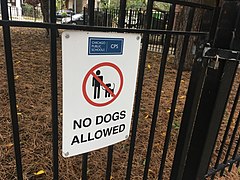Key:dog
| Description |
|---|
| Describes if dogs are allowed |
| Group: restrictions |
| Used on these elements |
| Documented values: 6 |
| Useful combination |
| See also |
|
| Status: de facto |
| Tools for this tag |
|
Describes whether dogs are legally allowed in a certain area (like a park) or if an amenity is meant to be used by dogs (for example a place to drink water).
As an access restriction
Due to a variety of reasons dogs may be explicitly (i.e., by means of signage) or implicitly (e.g., when local rules and regulations stipulate it) banned from certain ways or areas. The following tag-values can be used:
Some of these tags can be implied and may not need to be explicitly added. For example, dog=yes is not usually needed, particularly on highways (e.g. highway=footway), as this is the default where foot=yes is specified or implied. In the same way, dog=leashed tag may not be needed in jurisdictions where leash laws already mandate dogs be leashed on public roads. Also, the dog=unleashed tag may not be needed within a leisure=dog_park as this is implied.
Because dogs usually can't read signs, using dog=* as an access=*-value implies that the prohibition is aimed at people walking (or otherwise accompanying) one or more dogs, and should be understood as an additional restriction to the mode of transportation of whomever is taking the dog along — i.e., for routing purposes this tag should usually be seen as an addition to foot=* (although bicycle=* is not unthinkable).
Leashed or unleashed
It should be assumed that dog=yes implies no information about whether dogs are allowed unleashed as well. The default is that local leash laws should be observed; often this means that dogs are not allowed without a leash, except for specifically designated areas (e.g., leisure=dog_park, which implies that dogs are allowed to roam off the leash).
Assistance dogs
In many countries assistance dogs (such as guide dogs) may not be barred access from places accessible to the general public. Any use of dog=no should probably be understood with this exemption in mind (i.e., it is not necessary to explicitly allow access for guide dogs, because this is implied).
Conditional access
Access for dogs is sometimes conditional, such as being based on the time of day or year. In such cases, the conditional restriction tagging scheme should be used. Note that conditional tags override the default tags. For example, dog=yes and dog:conditional=no @ (May-Sep) indicates that dogs are allowed except between the months of May to September, and the combination of dog=leashed and dog:conditional=unleashed @ (00:00-08:00) means that dogs must be leashed except between midnight and 08:00 when they can be let off the leash.
As extra information on amenities
To clarify that an amenity is suitable or intended for dogs, dog=yes may be added.




